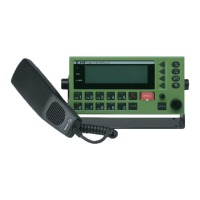2
MF/HF Fundamental Info
Propagation of MF and HF Radio
Waves.
MF/HF radiocommunications provide a medium and long range
service. The 1.6-4 MHz marine band is intended primarily for coastal
operation beyond normal VHF communication range. A reliable
range of more than 150 nautical miles can be expected in most
areas in the daytime, more in the nighttime. Propagation of the radio
waves in this band is mainly by ground waves i.e. the waves from
the transmitter aerial follow the earth’s curvature to the receiver
aerial. The high frequency range 4 - 30 MHz can provide
communication for hundreds or even thousands of nautical miles.
The long range is achieved by sky waves reflected from the iono-
sphere. Propagation of the radio waves depends on a number of
factors such as frequency, time of day, time of year, and solar
activity. The channels allocated to the maritime mobile service in the
HF range are divided into a number of bands: 4, 6, 8, 12, 16, 18, 22,
25 MHz to allow a suitable frequency band to be selected for
communication dependent on distance and time of day.
Radiotelephony
The mode of emission used for telephony transmissions in the
marine bands is SSB (single-sideband, J3E). On the international
distress frequency 2182 kHz compatible AM (amplitude modulation,
H3E) may be used in addition for communication with non-GMDSS
ships. AM mode is used also when receiving broadcasting. The
frequencies for radiotelephone distress and safety traffic in the HF
bands are 4125 kHz, 6215 kHz, 8291 kHz, 12290 kHz, and 16420
kHz. Working frequencies for public correspondence with coast
stations are arranged in pairs for duplex/semi-duplex operation. For
the HF bands these channels are allocated numbers by ITU on an
international basis. In addition a number of simplex frequencies are
available in each band for ship-to-ship communication.
Radiotelex
Marine telex is also referred to as ‘Narrow Band Direct Printing’
(NBDP). Due to the narrow bandwidth of the transmissions, a longer
range may be expected compared to radiotelephony. The frequen-
cies for radiotelex distress and safety traffic are 2174.5 kHz, 4177.5
kHz, 6268 kHz, 8376.5 kHz, 12520 kHz, and 16695 kHz. Working
frequencies for public correspondence with coast stations are
arranged in pairs. For the HF bands these channels are allocated
numbers by ITU on an international basis. In addition a number of
simplex frequencies are available in each band for ship-to-ship
communication.
DSC
DSC (Digital Selective Calling) is an automatic calling system which
allows a specific station to be contacted and made aware that a
station wishes to communicate with it. In addition to calls to specific
stations the system can also be used to call ‘all ships’ and groups of
ships and this is of significance for its use for DSC distress alerting.
DSC is an alerting signal only and the communication which follows
the call is made on an appropriate frequency band using radiote-
lephony or radiotelex. The frequencies for DSC distress and safety
calling are 2187.5 kHz, 4207.5 kHz, 6312 kHz, 8414.5 kHz, 12577
kHz, and 16804.5 kHz. Calling frequencies for public correspond-
ence with coast stations are arranged in pairs, both international and
national frequencies are assigned. In addition the frequency 2177
kHz may be used for ship-to-ship calling.

